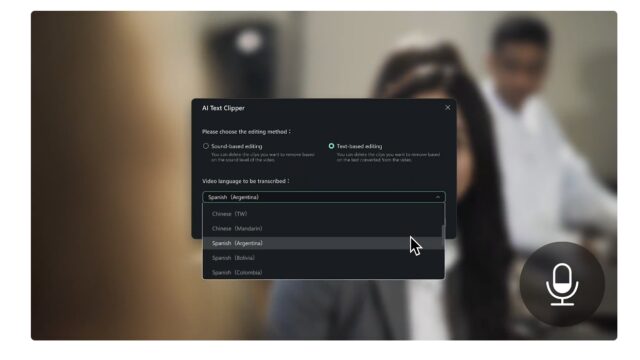Artificial Intelligence (AI) has become a part of video production, revolutionizing the sector, making it more efficient and also boosting creativity and access. AI audio to text conversion is one of the most significant developments as it enables speech in video to be converted into written form with unprecedented levels of precision. This technology is changing media production workflows, education, corporate training and beyond by making videos more accessible and manageable.
In this post, we will elaborate on AI audio-to-text conversion tech that underlies it, applications across industries and how it affects SEO and accessibility. We will also discuss business strategies for multilingualism and inclusivity based on AI-driven transcription as well as future prospects for artificial intelligence in video editing.
The Technology Behind AI Audio-to-Text Conversion: NLP and Machine Learning

AI audio-to-text conversion employs two main technologies – Natural Language Processing (NLP) and Machine Learning (ML).
Natural Language Processing (NLP)
NLP falls within the subset of AI which deals with computer interactions using human language:
- Speech Recognition: The AI algorithm listens to the audio and identifies spoken phrases and words. This procedure is much like how digital assistants like Siri or Google Assistant interpret voice commands.
- Language Modeling: The AI employs statistical models to identify and phrases based on context. This allows accuracy, specially in cases where the audio is not clear or has excessive background noise.
- Text Generation: Once the spoken words are identified, the AI converts them into textual content, making sure that the output is grammatically accurate and coherent.
Machine Learning (ML)
Machine Learning performs an important role in improving the accuracy and performance of audio-to-textual content conversion. Through ML, AI algorithms can learn from huge datasets of spoken and written language, allowing them to improve their transcription competencies over time. The more statistics the AI processes, the better it will become at spotting speech styles, identifying different accents, and managing diverse audio features.
ML moreover allows AI to conform to a particular persons needs. For example, if an AI transcription tool is used often in a selected industry, it is able to analyze jargon and terminology unique to the industry, ensuing correct transcriptions.
The Impact of Accurate Transcriptions on Accessibility and SEO
Accurate transcription of audio has a large impact on accessibility and search engine optimization and marketing, making it a crucial tool for video production.
Accessibility

Accessibility is a major concern for content creators and video producers. By offering transcriptions and subtitles for videos, creators can make certain that their movies are reachable to a much wider target market, including individuals with hearing impairments and people of different languages. This not only enhances the audience experience but also demonstrates a commitment to inclusivity. AI transcription software make it easier to generate accurate subtitles and transcripts, which can be seamlessly included into video content. This accessibility feature is mainly critical in instructional and educational videos, in which comprehension is vital.
SEO and marketing Benefits
From a search engine advertising and marketing perspective, transcribed content performs an important function in enhancing a video’s discoverability online. Search engines depend upon text to index and rank content, and transcriptions offer the vital text that search algorithms can crawl through. By transcribing video content, creators can enhance their video’s search engine ranking, making it much more likely to appear in search results. Additionally, transcriptions can be repurposed into web blog posts, articles, or social media content, in addition boosting the content’s visibility and reach. This multi-channel approach to content distribution is effective to maximize the impact of video production efforts.
Future Trends: Predictions on How AI Will Continue to Evolve inside the Video Editing Space
As AI keeps improving, we can expect even better audio-to-textual content conversion software tools that streamline video production strategies and enhance content accessibility. Here are some key developments to look for:
Enhanced Accuracy and Contextual Understanding
Future AI transcription toold are probable to acquire even higher levels of accuracy, thanks to upgrades in NLP and ML. These softwares might be better suited to deal with complicated audio, which includes overlapping speech, strong accents, background noise and audio distortions. Additionally, AI will enhance its potential to understand context, ensuring that transcriptions aren’t only correct but also contextually relevant.
Real-Time Transcription
Real-time transcription is another field in which AI is anticipated to make tremendous strides. Imagine a future where a video editor can see real time transcriptions as they record or edit a video, allowing for instant corrections and adjustments. This capability will significantly improve the efficiency of video production and allow more dynamic content creation.
Integration with Augmented Reality (AR) and Virtual Reality (VR)
As AR and VR generation become even better, AI transcription will, likely play a key role in growing immersive content. For example, in a virtual education consultation, AI can transcribe spoken commands into text that appears within the customer’s field of view, improving the learning experience.
Advanced Personalization
AI based text transcription software will become more personalised, adapting to the desire and requirements of individual users. This can also mean learning a person’s particular terminology, research industry specific jargon, or maybe recognizing someone’s precise speech styles for greater accuracy in transcriptions.
Greater Accessibility and Inclusivity
As AI transcription technology improves, it’s going to boom accessibility and inclusivity of content. This will encompass seamless integration of subtitles and captions in all varieties of media, to better combine more than one languages and dialects.
Conclusion
AI-based audio-to-text conversion is revolutionizing video production, imparting accuracy, and accessibility. By leveraging superior algorithms like NLP and ML, AI transcription softwares are reworking the way content is created and consumed in various industries. As corporations race to incorporate AI transcription for multilingual and inclusive content creation, AI’s impact on accessibility and SEO will expand further. Looking ahead AI’s integration in video editing will keep developing, bringing new possibilities for content creation and distribution in an increasingly digital market.







